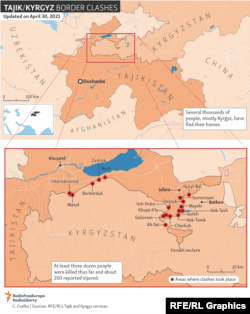Kyrgyzstan and Tajikistan have agreed to withdraw troops from a disputed border area following some of the worst clashes there in decades that left more than 40 people dead, including civilians, and dozens wounded.
The heads of national security for the two neighboring Central Asian countries agreed to the pullback during a meeting on May 1.
The announcement came after delegations from both countries met in the Batken region following a telephone conversation between Kyrgyz President Sadyr Japarov and his Tajik counterpart, Emomali Rahmon.
It also comes as tensions reportedly remain high in the area.
On May 1, RFE/RL reporters on the Kyrgyz side of the border said that they heard occasional shooting and saw Tajik forces blocking a road connecting Kyrgyzstan’s Batken and Leilek districts.
The Kyrgyz Border Service said it had registered Tajik military equipment moving in the direction of the border, after a cease-fire announced late on April 29 appeared to have put an end to some 24 hours of fighting.
The Kyrgyz Border Service also accused Tajik troops of firing on homes that had been evacuated in the Leilek district. It said this occurred as Kyrgyz border troops took up defensive positions.
However, a top official in the Tajik district of Bobojon Gafurov, which borders the Leilek district, denied that Tajik troops had opened fire in the area. He also denied that any roads had been blocked.
“The roads are all open, there are no obstacles to movement,” Akbar Yusufi told RFE/RL.
The violence, the worst and most widespread fighting the region has seen since the breakup of the Soviet Union in 1991, began on April 28 after a violent dispute between residents on both sides of the border over the installation of surveillance cameras at a water distribution point near Tajikistan’s Vorukh exclave drew in security forces from both countries.
Kyrgyzstan says 33 of its citizens were killed, including a girl born in 2008, and 163 were injured. Authorities said some 20,000 people, mainly women and children, were evacuated from villages near the border.
Tajikistan, an authoritarian state with tight control over the flow of information, said that nine of its citizens were wounded. Two of them were taken to hospital with gunshot wounds, officials said.
However, an RFE/RL correspondent based in the area identified 15 Tajik citizens killed in the clashes, including seven servicemen.
Both sides blamed each other for the escalation.
Earlier on May 1, Japarov signed a decree to declare a two-day period of nationwide mourning for victims of the violence, during which national flags will fly at half-mast across the country and at its diplomatic missions abroad.
Cultural institutions, as well as television and radio channels were asked to cancel entertainment events and programs.
In Tajikistan, a prayer for peace was read in mosques across the country during the previous evening.
Mahmud Sangaliyev, a representative of Tajikistan’s Council of Ulema, told RFE/RL that the prayer called for the preservation of calm in the border areas and “mutual understanding with neighbors.”
Like many other border areas in Central Asia, almost half of the 970-kilometer long Kyrgyz-Tajik border has not been demarcated, leading to tensions for the past 30 years.
The European Union and the head of the Organization for Security and Cooperation in Europe (OSCE) urged Kyrgyzstan and Tajikistan on April 30 to respect the cease-fire.
Peter Stano, the lead spokesperson for the European Union’s Foreign Affairs and Security Policy, said that both sides should “undertake all the necessary steps to avoid any conflict in the future.”
“The EU stands ready to provide, if needed, technical assistance through its regional programs dealing with border management and water management, as well as continued political support for a stability and prosperity in the region,” Stano said in a statement.
Calling the situation along the Kyrgyz-Tajik border “alarming,” Helga Maria Schmid, the secretary-general of the OSCE, said the cease-fire agreement between Dushanbe and Bishkek was “a step in the right direction.”
“I encourage adherence to #OSCE commitments through continued efforts and negotiations to further de-escalate the situation,” she tweeted.
Human Rights Watch said that the burning of “scores of houses” and the reported use of “explosive weapons with wide area effects” during the fighting should prompt Kyrgyzstan and Tajikistan to “immediately investigate civilian casualties and the destruction of civilian property, with a view to holding those responsible for serious laws-of-war violations to account, and provide appropriate remedies to civilians.”

